Links to various Aetna Better Health and non-Aetna Better Health sites are provided for your convenience. Aetna Better Health of California is not responsible or liable for non-Aetna Better Health content, accuracy or privacy practices of linked sites or for products or services described on these sites.
Our neighborhood health story: A weekend in the life of Philadelphia’s “secret” backyard
 By Bonnie Vengrow
By Bonnie Vengrow
Along the banks of the lower Schuylkill River, tucked between an oil refinery and a steady flow of trains ferrying crude oil, sits Philadelphia’s best-kept secret: Bartram’s Garden. The green space is the former estate of legendary botanist John Bartram, and although it’s been open free to the public since 1893, most Philadelphians either didn’t realize it existed or considered it the stuff of field trips and garden clubs. Even neighbors kept their distance, mistaking the manicured grounds for a private estate of the wealthy.
And really, who can blame them? That a 45-acre garden – complete with an historic home, botanic garden, a secret beach and a working farm – was in their backyard and theirs to use seemed unlikely. Southwest Philadelphia may be one of the most diverse areas of the city and one of the proudest – the zip code throws the most block parties – but it’s also one of the most underserved. Crime and poverty rates are higher here than the rest of Philadelphia County, and access to green space is uneven. Nearly three-quarters of the county lives near a park, according to data published through a collaboration between the Aetna Foundation and U.S. News and World Report. Most neighborhoods in Philadelphia can easily access the Schuylkill River Trail and the city’s famous 9,200-acre Fairmount Park system. The Southwest, however, has lacked any direct connection to such amenities.
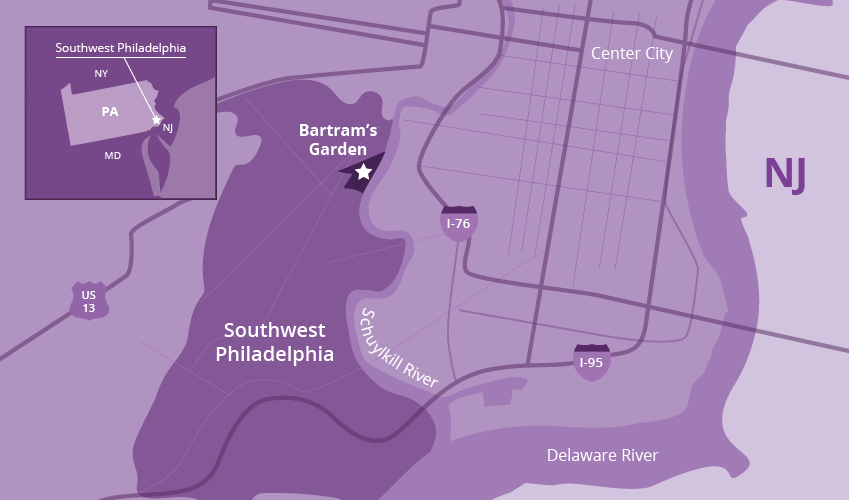
But Bartram’s Garden is working to bridge that gap and, in the process, change neighbors’ minds and hearts. For the last six years, the staff has been listening to community leaders and surveying residents to find out what people want and need from the space. The goal is to create a place where diversity is accepted and affirmed, where children are empowered to lead, and where community- and relationship-building can thrive, says Maitreyi Roy. Roy is the executive director of the John Bartram Association, which works with the city to steward and program Bartram’s Garden. “For us, the idea that this garden is a welcoming place for everybody goes to the heart of why we believe that civic spaces like this are truly the common ground,” she explains. “This garden is becoming the family room and the classroom of the community.”
A $100,000 grant from the Aetna Foundation is helping to fuel the team’s efforts, which include a community garden and farm; a public boating program; a youth leadership program; and a recreational trail extension that will finally connect residents with parks, amenities and resources downtown. “Bartram’s Garden has a clear vision for how to build up a community,” says Amy Aparicio Clark, managing director of community impact and strategy at the Aetna Foundation. “They understand the power of a garden to bring together residents who wouldn’t otherwise interact with one another. The Aetna Foundation is committed to funding projects like this one, which address community vitality through better access to green spaces.”
(The Aetna Foundation is also funding a cooking class series in Asheville, NC, and students there have formed a special community. Read more about it here.)
People who volunteer and work at Bartram’s Garden say that community-building happens there all the time – and they’re right. Here’s what that looked like one recent fall weekend.
Friday, 1:45 p.m.
Dr. Sylvia D. Briscoe, who sits on Bartram Garden’s board of directors, pushes past some leaves and admires a late-season eggplant growing in the community garden at the Sankofa Community Farm. Gardening brought her here four years ago. But it’s the sense of community that inspired her to become more involved. Whether she’s in the garden, at the boathouse or at the farm, she sees people of all ages working together. And it makes her happy.
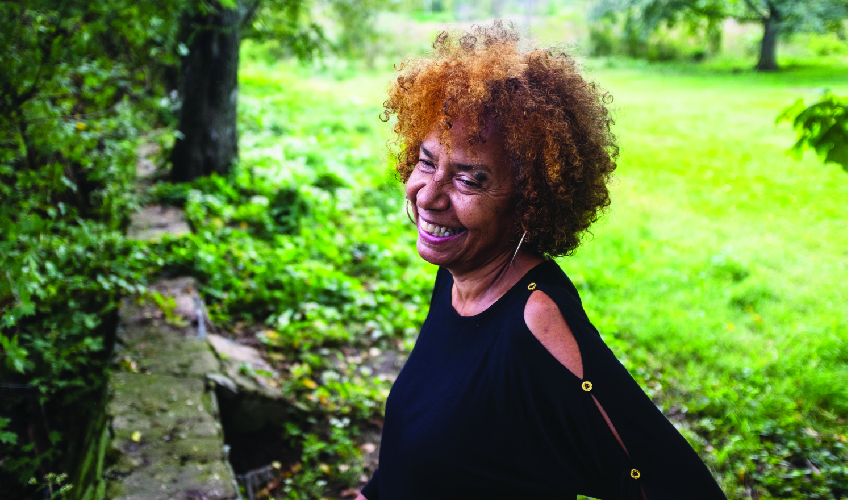
Of all the nooks and crannies in Bartram’s Garden, Dr. Briscoe prefers a quiet patch of land behind the farm.
“In our impoverished neighborhoods here, children are on a desert. Young people are not outside, they're not conversing with the neighbor down the street. And the neighbor's now scared of the kid. That's the reality,” Dr. Briscoe explains. “But we change that here at Bartram’s Garden. We have older people come in so the kids can talk to them, hear about their life experiences and what they might look forward to. It makes them hopeful to just have that conversation with somebody.”
Friday 3:12 p.m.
The catfish are practically leaping out of the lower Schuylkill River. Unfortunately, they all seem to be flocking to another angler. But George doesn’t seem to mind.
A resident of Northwest Philadelphia, he discovered Bartram’s earlier this year, after a local fisherman tipped him off. Between the natural beauty of the space and the abundance of fish in the river, George was hooked. He’s been fishing here once a month ever since. “It’s a hidden gem,” he says of Bartram’s Garden. “You know you’re in a city, because you see the skyline across the river. But you couldn’t ask for a better location.”
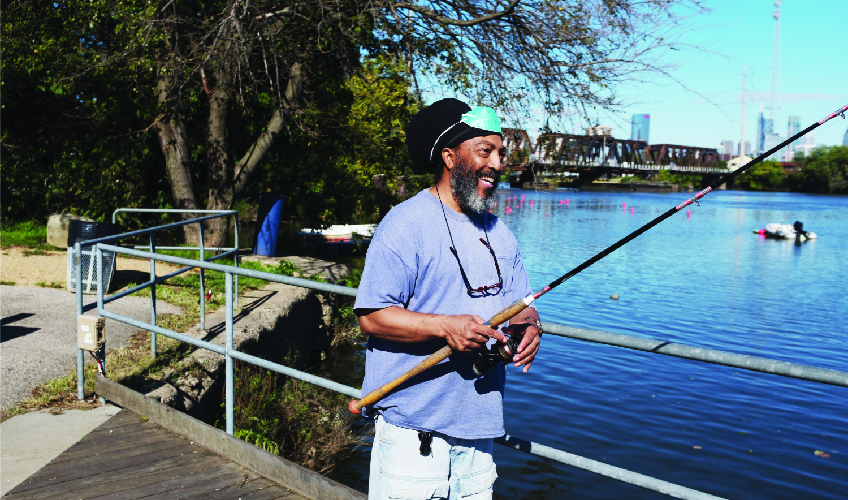
George has been fishing in this spot on the lower Schuylkill River since the spring.
He pauses and loads the hook with another chunk of smoked turkey – his bait of choice and one he shared with the lucky fisherman next to him. “People are starting to find out about this place,” he says. “I’m OK with that, though. It’s God’s creation, and it should be shared.”
Friday, 4:30 p.m.
The late-afternoon silence is punctured by enthusiastic voices shouting, “Step into your power! It’s time to transform!” It’s a familiar affirmation exercise for the kids in the Royal by Nature program, which meets at Bartram’s Garden after school and during the summer. Most of the children live in the neighborhood, and before this program had never stepped foot onto the property.
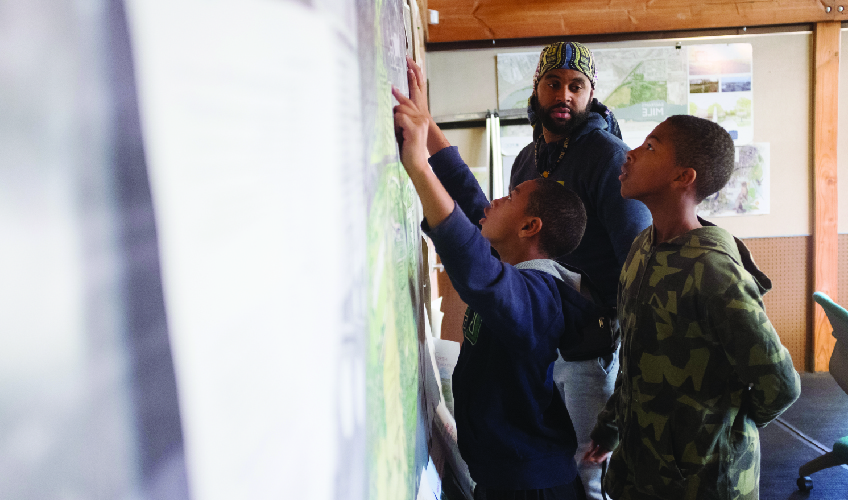
Camryn and his older brother, Syncere, show teacher Kyle J. R. Morris where they live on a map of the area.
Turns out, the grounds are an ideal classroom for teaching the kinds of life skills Royal by Nature imparts, says its founder Kyle J. R. Morris. “This summer, we taught the kids how to fish. They went boating. They learned to grow their own food and just get their hands dirty,” he says. “They made tree houses and learned to put the joysticks down and find the joy that's in the sticks, literally.”
After months of exploring the grounds, the kids still have a hard time choosing their favorite spot. “I like everywhere here,” says Syncere, 12. “Me too! I like it all equally,” says his brother, Camryn, 10. The decision is a little easier for Kyle. “I like where the people are,” he says.
Saturday, 8:45 a.m.
The Sankofa Community Farm’s stand at the Clark Park farmer’s market, in West Philadelphia, is a labor of love for Sybria. The high school junior and Bartram’s Garden intern not only helped plant, harvest and package the produce on the table this morning. She also spent hours familiarizing herself with each fruit and vegetable – what it tastes like, how to prepare it, how to pronounce it – in case any customers asked.
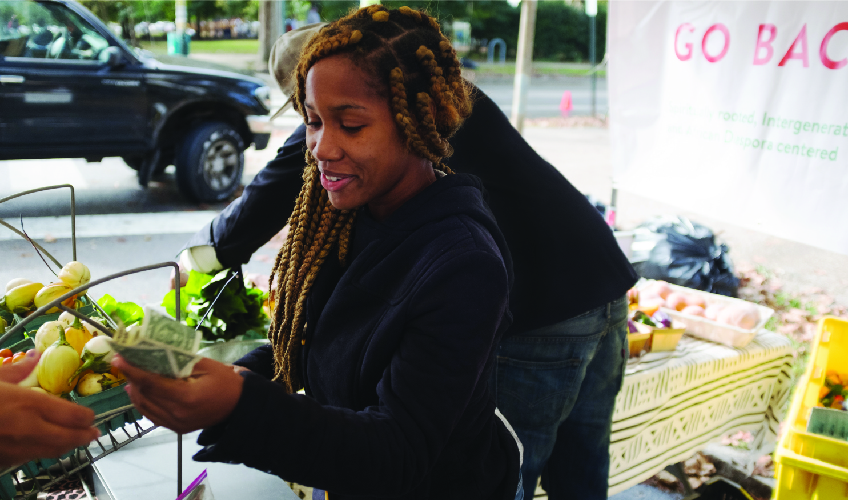
Every Saturday, Sybria helps run the Sankofa Community Farm’s stand at a farmer’s market in West Philadelphia.
Before this internship, she had never been to Bartram’s Garden or given a thought to agriculture. But working on the farm – and hearing stories from the older residents there – has inspired her to eat healthier. It’s also sparked an interest in learning more about her African ancestors and their role in our nation’s history. “Working here has made me grow as a person,” she says. “Before, I thought I had a lot of knowledge. But as I started to work here, I realized there’s so much I really don’t know, especially about my heritage. It made me ask myself, ‘Who do I want to teach me these things?’” It turns out that Sybria is learning as much from her elders about her heritage as she is about gardening.
Saturday, 11:13 a.m.
Sadé calls herself a plant mom. For the last two years, the Bartram’s Garden intern has tended to virtually everything growing in the Sankofa Community Farm. The work can be physically demanding for this 11th grader, but the rewards go beyond learning how to grow and cook food.
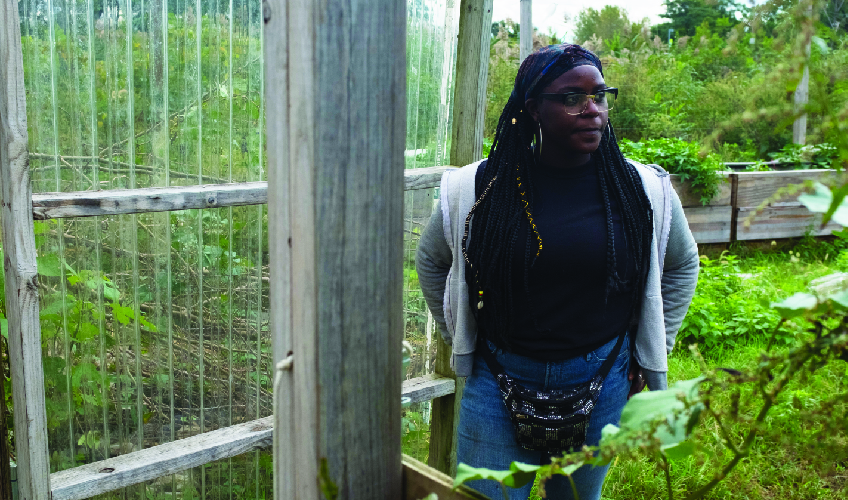
Sadé estimates she’s planted, tended to or harvested nearly everything at the Sankofa Community Farm.
Sadé has found mentors in Chris Bolden-Newsome and Ty Holmberg, the farm’s co-directors. “Chris teaches me so much about our culture and how it’s connected to food, and Ty brings up my spirits if I’m feeling depressed,” she says. Plus, there are the lasting friendships she’s formed. “We make bonds here we’ll never lose. One of my friends here, I consider her a sister. You make new sisters and brothers here all the time.”
Sunday, 2:05 p.m.
It’s one of the last weekends of the year for free public boating, and the river is already dotted with kayaks and rowboats. Ken can’t help but smile as he removes the life jacket. Just moments ago, he was on the water – the first time he’s gone boating since a near-accident decades ago. He admits he felt nervous before getting into the boat. “But now, I feel great,” he says. “I overcame my fear.”
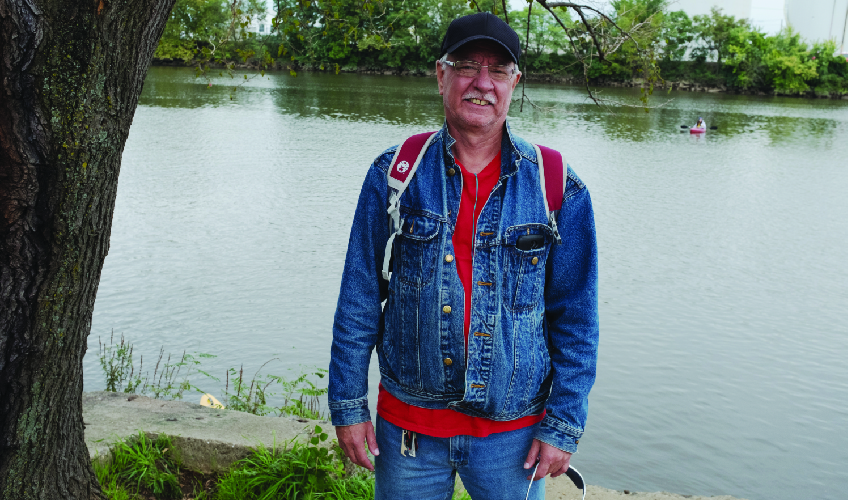
After a boating accident when he was younger, Ken finally decided to face his fear of the water by boating on the lower Schuylkill River.
Nearby is Yahsir, a 15-year-old intern in Bartram’s Garden boating program. He understands Ken’s relief. His aunt was involved in a boating accident when she was younger and for years avoided the water. But Yahsir recently persuaded her to join him on a quick boat ride. “She was scared when we went close to the oil refinery, but other than that, she liked it,” he says.
In fact, a big part of Yahsir’s job is to set up the hundreds of people who will boat this weekend with a rowboat made by local middle-schoolers or a single-seat kayak. His other responsibility is to help monitor the amount of bacteria in the water. If the levels are too high, he’ll notify Bartram’s Garden’s river staff and shut down boating for the day.
Because Yahsir sees firsthand what ends up in the river, he’s become more conscious about his own waste. Being surrounded by the beauty at Bartram’s Garden has that effect on you, he says.
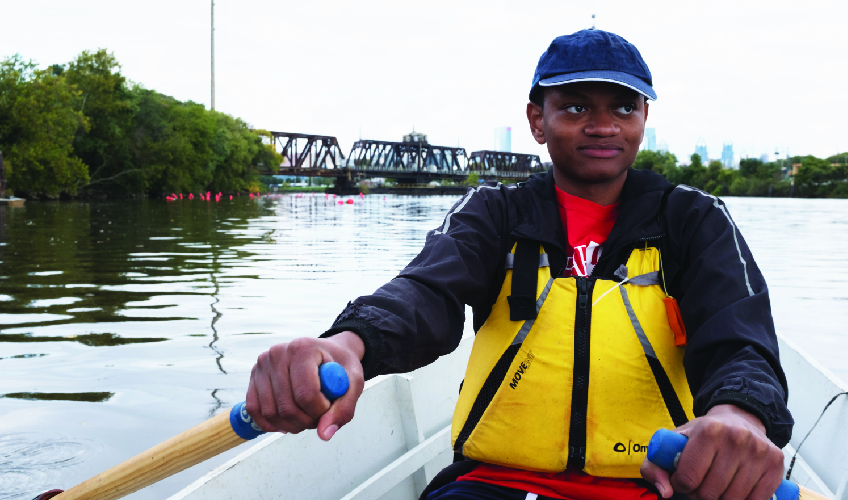
One of Yahsir’s duties as river program intern is to monitor the water’s bacteria levels and report his findings.
Sunday, 2:34 p.m.
The playground between the community garden and the farm is a buzz of activity. Today is Harvest Fest, an annual daylong event that draws some 1,400 visitors to Bartram’s Garden. Among them are Joe, his wife and their two children, who all live in the city. So far, the family has already gone on a horseback ride, visited the face painting table, and will soon move over to the hula hoops and potato sack races.
A university professor who specializes in the colonial era of John Bartram, Joe said he believes Bartram would approve of what’s happening on the grounds today – the activity, the exploration, the togetherness. “The garden is doing exactly what he wanted it to do,” he says. “He couldn’t have known how Philadelphia would transform, but I think he’d be happy.”
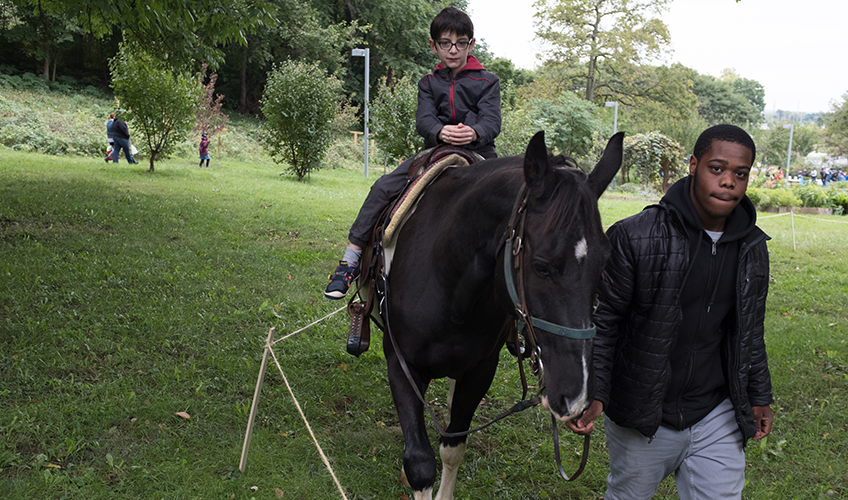
Joe’s son, Noah, enjoyed a horseback ride during this year’s Harvest Fest.
Indeed, the land Bartram tended to hundreds of years ago continues to be a place where life thrives. Maitreyi Roy, the executive director, notices it every day. In fact, a favorite part of her job is seeing how the grounds bring people together, whether that’s refugee families working alongside local elders in the community garden or people getting on the river for the first time. “It’s been extraordinary for us to see that this type of environment has a really important role to play in the community,” she says. “In these times where there’s so much division and hate, this is a place where people can connect with nature and with one another. They can find a little slice of beauty.”

Maitreyi Roy’s favorite spot at Bartram’s Garden is the meadow, which was reclaimed from industry a few decades ago.
Your community shapes how long and how well you live. The Aetna Foundation recently teamed up with U.S. News & World Report to rank counties across the U.S. on factors like education, nutrition, public safety and more. Out of nearly 3,000 counties assessed, we identified the 500 healthiest communities in America. In this series, we take a look at counties on the list where residents have identified a health challenge and are working to solve it with the help of a grant from the Aetna Foundation. Here, we profile Bartram’s Garden in Philadelphia County, PA, which has an overall health score that’s 9 points lower than the national average. Located in an economically depressed neighborhood, the garden is providing residents with a safe, natural place to connect with nature – and each other.
Sylvia Briscoe: It's really effected people to understand that Bartram Gardens is here for them. This space changed people's lives. I think that's what John Bartram wanted to do, and I think that's what we're doing.
Sylvia Briscoe: We live in all these isolated communities now. We have children that live places that don't have the options or had the access to what's available to them. That's why I jumped in two feet, and I thought, "Wow, they're just not growing food, they're doing phenomenal things."
Sylvia Briscoe: It brings in a plethora of people from different backgrounds, multi-generational, and a multicultural feel to it. It opens up something totally different, an attachment to the earth.
Maitreyi Roy: When I first came here, I walked around this garden, and I was struck by its extraordinary beauty, but what was really missing were people. I thought that this garden would really come alive if people could see it as part of their lives. For many years, this part of the city has been farmland, and the Bartram family made their home here.
Maitreyi Roy: One of the things that has been really wonderful is to see the role it plays in getting our young people ready for careers. Imagine this garden in the future entirely youth run. Imagine that your tour guide is a young student who is learning about being an educator in the community. Our hope is that in the future, we have this entire garden be a model for how our young people in the community can take charge.
Sylvia Briscoe: Bartram's mission is not very different, even though it was centuries ago, than today's mission. We just made it a 21st century thing to serve community.